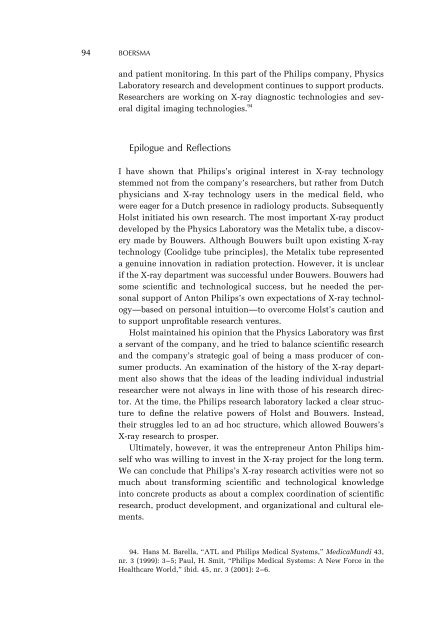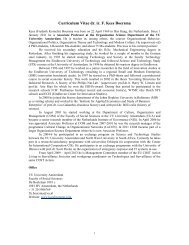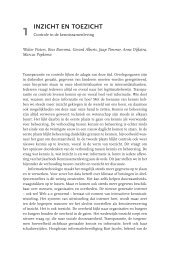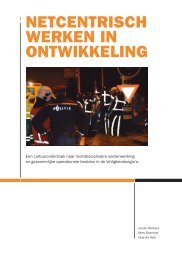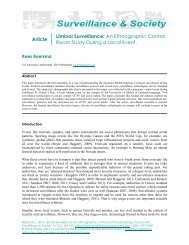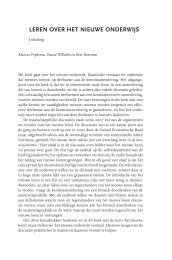Access article in PDF - Project MUSE - Johns Hopkins University
Access article in PDF - Project MUSE - Johns Hopkins University
Access article in PDF - Project MUSE - Johns Hopkins University
Create successful ePaper yourself
Turn your PDF publications into a flip-book with our unique Google optimized e-Paper software.
94 BOERSMA<br />
and patient monitor<strong>in</strong>g. In this part of the Philips company, Physics<br />
Laboratory research and development cont<strong>in</strong>ues to support products.<br />
Researchers are work<strong>in</strong>g on X-ray diagnostic technologies and several<br />
digital imag<strong>in</strong>g technologies. 94<br />
Epilogue and Reflections<br />
I have shown that Philips’s orig<strong>in</strong>al <strong>in</strong>terest <strong>in</strong> X-ray technology<br />
stemmed not from the company’s researchers, but rather from Dutch<br />
physicians and X-ray technology users <strong>in</strong> the medical field, who<br />
were eager for a Dutch presence <strong>in</strong> radiology products. Subsequently<br />
Holst <strong>in</strong>itiated his own research. The most important X-ray product<br />
developed by the Physics Laboratory was the Metalix tube, a discovery<br />
made by Bouwers. Although Bouwers built upon exist<strong>in</strong>g X-ray<br />
technology (Coolidge tube pr<strong>in</strong>ciples), the Metalix tube represented<br />
a genu<strong>in</strong>e <strong>in</strong>novation <strong>in</strong> radiation protection. However, it is unclear<br />
if the X-ray department was successful under Bouwers. Bouwers had<br />
some scientific and technological success, but he needed the personal<br />
support of Anton Philips’s own expectations of X-ray technology—based<br />
on personal <strong>in</strong>tuition—to overcome Holst’s caution and<br />
to support unprofitable research ventures.<br />
Holst ma<strong>in</strong>ta<strong>in</strong>ed his op<strong>in</strong>ion that the Physics Laboratory was first<br />
a servant of the company, and he tried to balance scientific research<br />
and the company’s strategic goal of be<strong>in</strong>g a mass producer of consumer<br />
products. An exam<strong>in</strong>ation of the history of the X-ray department<br />
also shows that the ideas of the lead<strong>in</strong>g <strong>in</strong>dividual <strong>in</strong>dustrial<br />
researcher were not always <strong>in</strong> l<strong>in</strong>e with those of his research director.<br />
At the time, the Philips research laboratory lacked a clear structure<br />
to def<strong>in</strong>e the relative powers of Holst and Bouwers. Instead,<br />
their struggles led to an ad hoc structure, which allowed Bouwers’s<br />
X-ray research to prosper.<br />
Ultimately, however, it was the entrepreneur Anton Philips himself<br />
who was will<strong>in</strong>g to <strong>in</strong>vest <strong>in</strong> the X-ray project for the long term.<br />
We can conclude that Philips’s X-ray research activities were not so<br />
much about transform<strong>in</strong>g scientific and technological knowledge<br />
<strong>in</strong>to concrete products as about a complex coord<strong>in</strong>ation of scientific<br />
research, product development, and organizational and cultural elements.<br />
94. Hans M. Barella, “ATL and Philips Medical Systems,” MedicaMundi 43,<br />
nr. 3 (1999): 3–5; Paul, H. Smit, “Philips Medical Systems: A New Force <strong>in</strong> the<br />
Healthcare World,” ibid. 45, nr. 3 (2001): 2–6.


